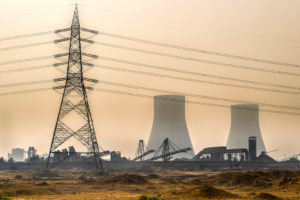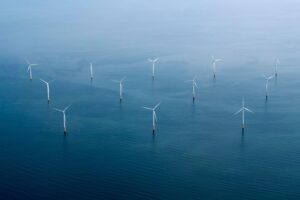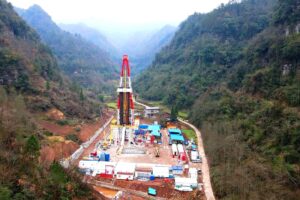Welcome to Carbon Brief’s China Briefing.
China Briefing handpicks and explains the most important climate and energy stories from China over the past fortnight. Subscribe for free here.
Key developments
China’s CO2 emissions down
STRUCTURAL DECLINE: China’s clean power generation growth has, for the “first time”, been the driver of a fall in the nation’s carbon dioxide (CO2) emissions levels, new analysis for Carbon Brief found. CO2 emissions were down 1.6% year-on-year in the first quarter of 2025 and have fallen 1% over the last 12 months, it added, driven by decreasing power sector emissions – all despite rapid electricity demand growth. This could mark a “potentially significant turning point” in China’s emissions trajectory, the analysis said.
BOOMING INDUSTRIES: China’s clean-energy sectors have been “developing rapidly”, China’s tax bureau said, with the sectors’ sales revenue growing 13.6% year-on-year – “11.5 percentage points higher than the national average”, according to industry news outlet China Energy News. Analysis by the Oxford Institute for Energy Studies noted “production of the ‘three new’ industries was strong” in the first quarter of 2025. More than 3m workers were employed in the “ecological and environmental protection sector” in China in 2024, Chinese financial news outlet Yicai said. Meanwhile, Chinese finance news outlet Caixin reported on Shandong and Guangdong becoming the first two provinces in China to issue “market-based pricing rules for wind and solar power”, in a policy push that is expected to create short-term uncertainty for clean-energy industries.
COAL ASSETS: China’s fossil fuel sector emitted “nearly 25m tonnes of methane” in 2024 – the vast majority of which came from coal mines, including abandoned mines, a new report by the International Energy Agency said. It added that fossil-fuel methane emissions in China are set to fall by nearly 15% by 2030 and by around 30% by 2035. Elsewhere, carbon offsetting company Verra has developed a new methodology that could “channel more private capital toward the early phase out of coal-fired power plants” in Asia, Bloomberg said. However, Yan Qin, principal analyst at ClearBlue Markets, told Carbon Brief that Chinese stakeholders are “unlikely” to use the credits as they are not recognised in China’s voluntary carbon market. The state-run newspaper China Daily reported that China developed a “deep-sea vault” for greenhouse gases in the South China Sea, designed to store 1.5m tonnes of CO2 annually.
Drought hit China’s breadbasket

DROUGHT: Severe drought has hit several provinces across China, including Henan, Jiangsu and Shaanxi, with high temperatures and low rainfall “affecting local farming and water resources”, Yicai reported. Bloomberg noted that the “hot and dry weather is threatening wheat production, potentially disrupting output”. One trading firm has trimmed its forecast of China’s wheat production for 2025, Reuters reported. Upcoming summer monsoonal rains, known as meiyu (梅雨), “could help ease concerns over crop development”, Bloomberg said, although it added that global warming appeared to be driving “wild swings” in rainfall patterns during the season.
PESTS: A new study from Peking University, covered by the Hong Kong-based South China Morning Post (SCMP), found that migratory pests from southeast Asia are “partially driving rice yield losses in southern China”. The researchers added that “continued global warming” will likely increase how often issues with crop pests arise, “posing a major obstacle to stabilising food production”. China has released a plan for disaster prevention during 2025’s flood season in order to ensure a “bumper harvest”, which includes measures to prevent damage from floods, drought, heat, typhoons and pests, the state-run newspaper China Daily said.
POLLEN: Meanwhile, Beijing’s forestation drive has led to a rise in cases of hay fever, Bloomberg reported, noting that trees commonly used in the programme, such as “willows and poplar trees”, have high pollen output. It added that, according to environmental experts, China “didn’t have a better choice of plants when it started the forestation campaign” – quoting one saying that the country’s goal was to “get green first, and then to consider other things”.
Global south policymakers in Beijing
RENEWABLES TO AFRICA: New research by UK-based thinktank ODI Global has found that solar and wind power projects accounted for 59% of China’s energy investments in Africa in 2024, SCMP said. South African policymakers travelled to China to discuss “large-scale renewable energy”, “clean coal” and “grid management” with Chinese counterparts and industry representatives, according to the Communist party-affiliated newspaper People’s Daily. Elsewhere, Nigeria “recently floated, and then quickly walked back, a proposed ban on imported solar panels” as the country tries to develop its own local solar industry, the China Global South Project reported.
-
Sign up to Carbon Brief’s free “China Briefing” email newsletter. All you need to know about the latest developments relating to China and climate change. Sent to your inbox every Thursday.
MONEY TO CELAC: Meanwhile, representatives of Latin American and Caribbean countries travelled to Beijing for a forum hosted by China, in which President Xi Jinping pledged to provide “66bn yuan ($9bn) in credit” and expand cooperation in “clean energy” with the region, SCMP reported. The “Beijing declaration” issued after the forum emphasised the need for “all parties to consider acceding to international instruments on climate change…and avoiding the creation of new trade barriers”.
LULA TO CHINA: Brazilian president Luiz Inácio Lula da Silva was also in China on a state visit, the New York Times said, noting that Lula was seeking “gains in new technologies, including…green energy”. His visit culminated in Chinese companies announcing $5bn in investments in Brazil, Brazilian newspaper Folha de S.Paulo reported, including in “sustainable aviation fuel”, “electric and hybrid cars” and other energy-related projects. A joint statement issued by the two countries stated that they will “deepen cooperation” on the energy transition and stated China will “send a high-level delegation” to COP30.
XI TO RUSSIA: Earlier, Xi made a state visit to Russia, during which Chinese and Russian policymakers discussed “Chinese companies’ involvement in Russian liquefied natural gas (LNG) projects”, Reuters reported. A joint statement, published by China’s Ministry of Foreign Affairs, pledged to implement projects “in the fields of oil, gas, LNG, civilian nuclear energy, coal, electricity [and] renewable energy”. State broadcaster CGTN called the China-Russia east-route gas pipeline, which began operating last December, a “landmark” in energy cooperation “benefiting about 450m people along its route”. Oleg Deripaska, chairman of the ecological committee of the China-Russia Friendship Committee for Peace and Development, told the People’s Daily: “Russia can learn from China’s experience of supply-side structural reforms to promote the creation of a mature green energy market.”
Captured
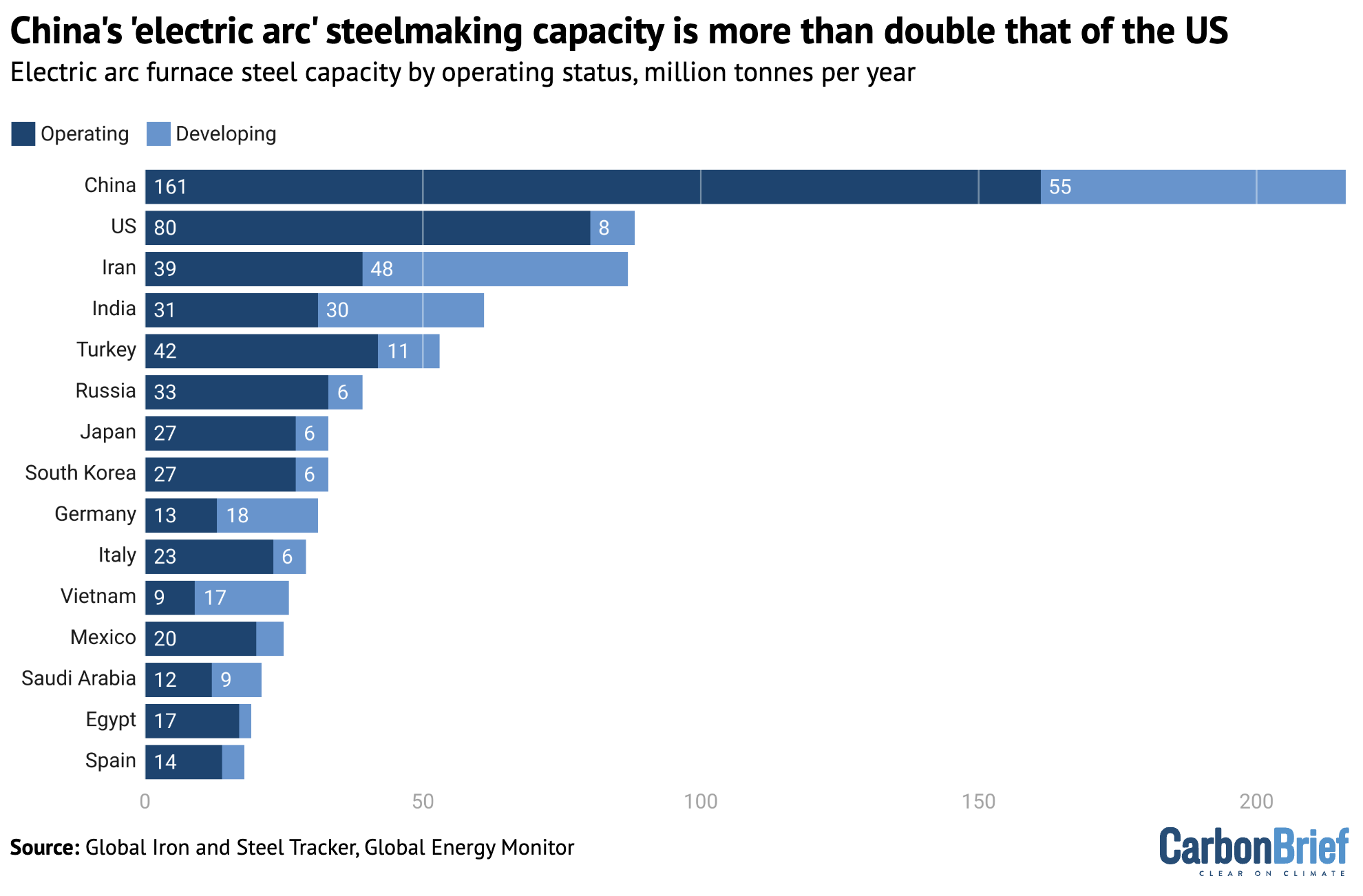
China currently has 161m tonnes (Mt) per year of electric arc furnace (EAF) steelmaking capacity and is building another 55Mt, according to a new data analysis tool developed by energy thinktank Global Energy Monitor. However, it noted, China “exhibits substantial gaps in data availability”, with feedstock information available for less than 8% of its EAF capacity.
Spotlight
What China’s coal country thinks about climate change
A new survey of Shanxi residents, exploring attitudes to climate change and “just transition”, offers a rare insight into the views of Chinese people on the frontline of the energy transition in the country’s largest coal-producing province.
In this issue, Carbon Brief interviews Tom Wang, one of the organisers of the survey, about its key findings. Wang is executive director of People of Asia for Climate Solutions, a climate advocacy group.
This interview was edited for length and clarity. A full version is available on Carbon Brief’s website.
Carbon Brief: Why did you want to conduct this survey?
Tom Wang: I’m from Shanxi province. I grew up thinking that coal was a necessary part of life. But I also lost quite a lot of people in my family to coal-mine accidents or air pollution.
Shanxi province is the world’s largest coal producer. [Note: The province’s coal output reached 1.3bn tonnes in 2024.] We contribute around one-third of [China’s] coal. Millions of people rely on coal-related jobs.
[But China’s climate policies mean] Shanxi cannot depend on the coal economy. Shanxi province’s own policies have also covered the energy transition. These policies [are not] being translated into something more tangible to people’s lives. People are not prepared.
That is why we wanted to do this survey. We ask two simple questions: do you know about and support the energy transition – and are you prepared?
CB: What do people in Shanxi think about the energy transition, climate change and climate policy?
TW: When it comes to climate change, awareness levels are very different between different demographic groups. For example, government workers and people with higher income or education levels know about climate change.
Some could identify things happening around them, such as warmer temperatures every year, longer drought periods and not having any snow last winter. Some even mentioned extreme weather, including heatwaves and a week-long rainstorm that ruined a lot of Shanxi’s ancient temples.
However, the most vulnerable communities, by which I basically mean the coal community, don’t really know about climate change. They know about [climate] buzzwords, but they don’t really understand them.
CB: Why is that?
TW: Most state-owned media talk a lot about climate change. However, they do not explain what that means for people’s everyday lives.
When we explain the energy transition means we are going to use less coal, they can understand…and feel the impact on their lives quite sharply.
CB: The survey also asked people what they would like to see prioritised in a just transition away from coal. What did respondents say was important to them?
TW: We all know JET-P, the Just Energy Transition Partnership. However, in Shanxi province, what we really need is the JET-B, a Just Energy Transition Brotherhood.
Rich provinces in China relied heavily on Shanxi’s coal to develop their economies. [The JET-B calls on them to] support Shanxi with its energy transition. Many [respondents] agreed with this!
Also, the people of Shanxi are actually willing to change or improve their own skill-sets. They know how dangerous it is to work in the coal industry. There is a high awareness of the lack of a future for the coal industry among respondents. People are quite happy to move on, if they are provided with good training and strong support to help that transition go smoothly.
CB: According to the survey, just over a quarter of Shanxi’s young people felt they did not have the skills they needed for a clean-energy economy. Around half were worried about the closure of coal mines and coal-power plants. What can be done to address their concerns?
TW: In Shanxi province we have universities that are dedicated to the coal industry. We have spent so much energy and resources on preparing our young people for the coal industry, instead of preparing them for the transition away from coal.
Young people don’t know how to prepare for the energy transition. And then there’s the current job market. Shanxi’s economy is so weak – in 2024, our province had the lowest economic growth rate in China.
Shanxi is not very good at setting up new industries. We have all of this potential but we are not really translating it into jobs. That’s why the young generation doesn’t feel confident.
CB: What lessons should be taken away from the survey?
TW: We need to prepare…the coal community and the young generation today. We cannot afford to wait any longer. We need to tangibly start to train people and raise new sectors.
Communications are also critical. We need to inspire people. Young people and the coal community are feeling lost.
We need to highlight that all these [possibilities] are out there. That’s what I would like our policymakers, investors and NGOs to tell people. And richer provinces should step up and say: “Now it’s time for us to help you.”
Watch, read, listen
CLIMATE SCIENCE: The Science and Technology Daily interviewed Prof Liu Congqiang, founding dean of the School of Geosystem Science of Tianjin University, on how the earth systems discipline emerged in China and how it contributes to researching climate change.
NEW STRATEGIES: The Diplomat examined how ambitious climate diplomacy can be sustained without high-level climate cooperation between the US and China.
CLIMATE LEADER: Global Solutions published an article by Henry Huiyao Wang, founder and president of the influential thinktank Center for China and Globalization, on how China can “leverage” its energy transition successes to advance “global climate mitigation”.
ELECTROSTATE: The Financial Times explored how China’s growing electrification helps it overcome a number of geopolitical, security and supply chain “vulnerabilit[ies]”.
New science
Nature Food
China’s agricultural machinery emissions have increased nearly sevenfold since 1985, new research has shown, adding that if they continue to grow they could “hinder” the country’s ability to reach its carbon-neutrality targets. The study, covered by Carbon Brief, used data from the China “statistical yearbook” to calculate the emissions of four types of farm equipment. Prof Zhangcai Qin, a professor at Sun Yat-sen University who was not involved in the new study, told Carbon Brief that disaggregating the emissions of agricultural machinery from food systems more broadly “allow[s] policymakers to design targeted interventions without compromising agricultural productivity”.
Communications Earth & Environment
A new study found that China’s “young natural forests” currently store more above-ground carbon than comparable “young planted forests” – mainly due to differences in tree density. The authors mapped the “aboveground carbon accumulation rates” for China’s young “natural” and “planted” forests in 2020. They found that planted forests sequester carbon more quickly than natural forests. However, they projected that by 2060, natural forests will still hold more above-ground carbon than planted forests.
A new study used machine learning to calculate a possible carbon emissions trajectory for China through to 2030. It mapped China’s carbon
China Briefing is compiled by Wanyuan Song and Anika Patel. It is edited by Wanyuan Song and Dr Simon Evans. Please send tips and feedback to china@carbonbrief.org
The post China Briefing 15 May 2025: CO2 emissions fall; Drought affects food production; Climate diplomacy at CELAC appeared first on Carbon Brief.
Greenhouse Gases
DeBriefed 10 October 2025: Renewables power past coal; Legacy of UK’s Climate Change Act; Fukushima’s solar future
Welcome to Carbon Brief’s DeBriefed.
An essential guide to the week’s key developments relating to climate change.
This week
Renewables overtake coal
‘HISTORIC FIRST’: Renewables have overtaken coal to become the world’s leading source of electricity for the first six months of this year in a “historic first”, BBC News said. The analysis, from the thinktank Ember, found the world generated “almost a third” more solar power in the first half of the year, compared with the same period in 2024, while wind power grew by “just over 7%,” reported the Guardian.
HEAVY LIFTING: According to the report, China and India were “largely responsible for the surge in renewables”, while the US and Europe “relied more heavily on fossil fuels,” the Guardian wrote. China built more renewables than every other country combined in the first half of this year, the newspaper added.
CONTINENTAL SHIFTS: A second report from the International Energy Agency (IEA) predicted a “surge” in global wind and solar capacity by 2030, but shaved 5% off its previous forecast, the Financial Times said. The IEA revealed that India is set to become the second-largest growth market for renewables after China, “with capacity expected to increase 2.5 times by 2030”, Down to Earth reported. The IEA also upped its forecast for renewables in the Middle East and north Africa by 23%, “helped by Saudi Arabia rolling out wind turbines and solar panels”, but halved the outlook for the US, the FT noted.
Around the world
- EV BOOM: Sales of electric and hybrid cars made up “more than half” of all new car registrations in the UK last month, a new record, according to data from the Society of Motor Manufacturers, reported BBC News.
- BANKING COLLAPSE: A global banking alliance launched by the UN to get banks to slash the carbon footprint of their loans and investments and help drive the transition to a net-zero economy by 2050 has collapsed after four years, Agence France-Press reported.
- CUTS, CUTS, CUTS: The Trump administration plans to cut nearly $24bn in funding for more than 600 climate projects across the US, according to documents reviewed by the Wall Street Journal.
- PEOPLE POWER: A farmer, a prison guard and a teacher were among those from the Dutch-Caribbean island Bonaire who appeared at the Hague on Tuesday to “accuse the Netherlands of not doing enough to protect them from the effects of climate change”, Politico reported.
400,000
The number of annual service days logged by the US National Guard responding to hurricanes, wildfires and other natural disasters over the past decade, according to a Pentagon report to Congress, Inside Climate News reported.
Latest climate research
- Politicians in the UK “overwhelmingly overestimate the time period humanity has left to bend the temperature curve”, according to a survey of 100 MPs | Nature Communications Earth and Environment
- Fire-driven degradation of the Amazon last year released nearly 800m tonnes of CO2 equivalent, surpassing emissions from deforestation and marking the “worst Amazon forest disturbance in over two decades” | Biogeosciences
- Some 43% of the 200 most damaging wildfires recorded over 1980-2023 occurred in the last decade | Science
(For more, see Carbon Brief’s in-depth daily summaries of the top climate news stories on Monday, Tuesday, Wednesday, Thursday and Friday.)
Captured

The UK’s Climate Change Act, landmark legislation that guides the nation’s response to climate change, is increasingly coming under attack from anti-net-zero right-leaning politicians. In a factcheck published this week, Carbon Brief explained how the UK’s Climate Change Act was among the first comprehensive national climate laws in the world and the first to include legally binding emissions targets. In total, 69 countries have now passed “framework” climate laws similar to the UK’s Climate Change Act, with laws in New Zealand, Canada and Nigeria among those explicitly based on the UK model. This is up from just four when the act was legislated in 2008. Of these, 14 are explicitly titled the “Climate Change Act”.
Spotlight
Fukushima’s solar future
This week, Carbon Brief examines how Fukushima helped to recover from nuclear disaster by building solar farms on contaminated farmland.
On 11 March 2011, an earthquake off the pacific coast of Japan caused 15m-tall waves to crash into the eastern region of Tōhoku, killing 19,500 people and injuring a further 6,000.
In the aftermath, flooding at the Fukushima Daichi nuclear power plant caused cooling systems to fail, leaching radioactive contaminants into the soil and leading to a major nuclear incident.
Some 1,200km2 around the site was restricted and up to 100,000 people were evacuated – in some cases forever.
In the years following, Japan entered a fraught debate about nuclear energy.
In 2010, nuclear power provided 25% of Japan’s electricity, but, in the years following the disaster, its 54 nuclear reactors were taken offline.
Successive governments have fought over reintroducing nuclear power. Today, some 14 reactors are back online, 27 have been permanently closed and another 19 remain suspended. (Japan’s newly-elected prime minister Sanae Takaichi has promised to make nuclear central to her energy strategy.)
Against this backdrop, Fukushima – a prefecture home to 1.8 million people – has emerged as a surprise leader in the renewables race.
In 2014, the Fukushima Renewable Energy Institute (FREA) opened with the twin goals of promoting research and development into renewable energy, while “making a contribution to industrial clusters and reconstruction”.
That same year, the prefecture declared a target of 100% renewable power by 2040.
Contaminated land
“A lot of these communities, I know, were looking for ways to revitalise their economy,” said Dr Jennifer Sklarew, assistant professor of energy and sustainability at George Mason University and author of “Building Resilient Energy Systems: Lessons from Japan”.
Once evacuation orders were lifted, however, residents in many parts of Fukushima were faced with a dilemma, explained Skarlew:
“Since that area was largely agricultural, and the agriculture was facing challenges due to stigma, and also due to the soil being removed [as part of the decontamination efforts], they had to find something else.”
One solution came in the form of rent, paid to farmers by companies, to use their land as solar farms.
Michiyo Miyamoto, energy finance specialist at the Institute for Energy Economics and Financial Analysis, told Carbon Brief:
“The [Fukushima] prefecture mapped suitable sites early and conducted systematic consultations with residents and agricultural groups before projects were proposed. This upfront process reduced land-use conflicts, shortened permitting timelines and gave developers clarity.”
As a result, large-scale solar capacity in Fukushima increased to more than 1,300 megawatts (MW) from 2012 to 2023, according to Miyamoto. Moreover, installed renewable capacity now exceeds local demand, meaning the region can run entirely on clean power when conditions are favourable, Miyamoto said.
Today, aerial pictures of Fukushima reveal how solar panels have proliferated on farmland that was contaminated in the nuclear disaster.

Charging on
Last year, 60% of Fukushima’s electricity was met by renewables, up from 22% in 2011. (The country as a whole still lags behind at 27%.)
And that is set to grow after Japan’s largest onshore windfarm started operations earlier this year in Abukuma, Fukushima, with a capacity of 147MW.
The growth of solar and wind means that Fukushima is already “ahead of schedule” for its 2040 target of 100% renewable power, said Miyamoto:
“The result is a credible pathway from recovery to leadership, with policy, infrastructure and targets working in concert.”
Watch, read, listen
OVERSHOOT: The Strategic Climate Risks Initiative, in partnership with Planet B Productions, has released a four-part podcast series exploring what will happen if global warming exceeds 1.5C.
DRONE WARFARE: On Substack, veteran climate campaigner and author Bill McKibben considered the resilience of solar power amid modern warfare.
CLIMATE AND EMPIRE: For Black history month, the Energy Revolution podcast looked at how “race and the legacies of empire continue to impact the energy transition”.
Coming up
- 12 October: presidential elections, Cameroon
- 13-14 October: Pre-COP, Brasilia, Brazil
- 13-18 October: World Bank Group/IMF annual meetings, Washington DC
- 14-17 October: 2nd extraordinary session of the Marine Environment Protection Committee at the International Maritime Organisation, London
- 15-16 October: Circle of Finance Ministers report
Pick of the jobs
- Buckinghamshire Council, principal climate change officer | Salary: £49,354-£51,759. Location: Aylesbury, Buckinghamshire
- Sustainable NI, sustainable business lead | Salary: £60,000. Location: Belfast, Northern Ireland
- Dialogue Earth, South Asia managing editor | Salary: £1,875 per month. Location: South Asia
DeBriefed is edited by Daisy Dunne. Please send any tips or feedback to debriefed@carbonbrief.org.
This is an online version of Carbon Brief’s weekly DeBriefed email newsletter. Subscribe for free here.
The post DeBriefed 10 October 2025: Renewables power past coal; Legacy of UK’s Climate Change Act; Fukushima’s solar future appeared first on Carbon Brief.
Greenhouse Gases
Guest post: How Caribbean states are shifting climate legislation
The Caribbean region is among the most vulnerable to climate change, despite historically contributing less than half of one percent of global greenhouse gas emissions.
Rising sea levels, extreme heat and more frequent and intense storms – such as the 2024 Hurricane Beryl, which made landfall in Grenada – pose urgent and growing threats to the small island states, coastal nations and overseas territories that comprise the Caribbean region.
With global progress to address climate change still too slow, Caribbean countries are taking matters into their own hands by enacting more robust legislation to help protect against climate risks.
In a new study published in the Carbon and Climate Law Review, we identified 78 climate laws and legally binding decrees across 16 Caribbean states, as well as two constitutional references to climate change and a growing recognition of the right to a healthy environment.
Our analysis suggests that, together, these developments are not only enhancing resilience, but also positioning Caribbean states as influential actors in the global climate arena.
Caribbean climate laws on the rise
Climate governance in the Caribbean has expanded significantly in recent years. In the past decade, countries such as Cuba and the Dominican Republic have embedded climate obligations and programmatic guidelines into their national constitutions.
At the same time, legislative recognition of the human right to a healthy environment is gaining momentum across the region. Six Caribbean nations now affirm the right in their constitutions, while 15 have recognised it through international instruments, such as the UN Council, UN Assembly and the Escazu Agreement, as shown in the figure below.

More recently, there has been a notable rise in targeted, sector-specific climate frameworks that go beyond broader environmental statutes.
Saint Lucia stands out as the only country with a climate framework law, or a comprehensive national law that outlines long-term climate strategies across multiple domains. Meanwhile, several other Caribbean governments have adopted climate-specific laws that focus on individual sectors, such as energy, migration and disaster management.
According to our analysis, more than a quarter of climate-relevant legislation in the region – comprising 21 laws and legally binding decrees – now has an explicit focus on climate change, as illustrated in the chart below.
Our research suggests that this represents an ongoing shift in legislative focus, reflecting changes in how climate legislation is being structured in one of the world’s most climate-vulnerable regions.
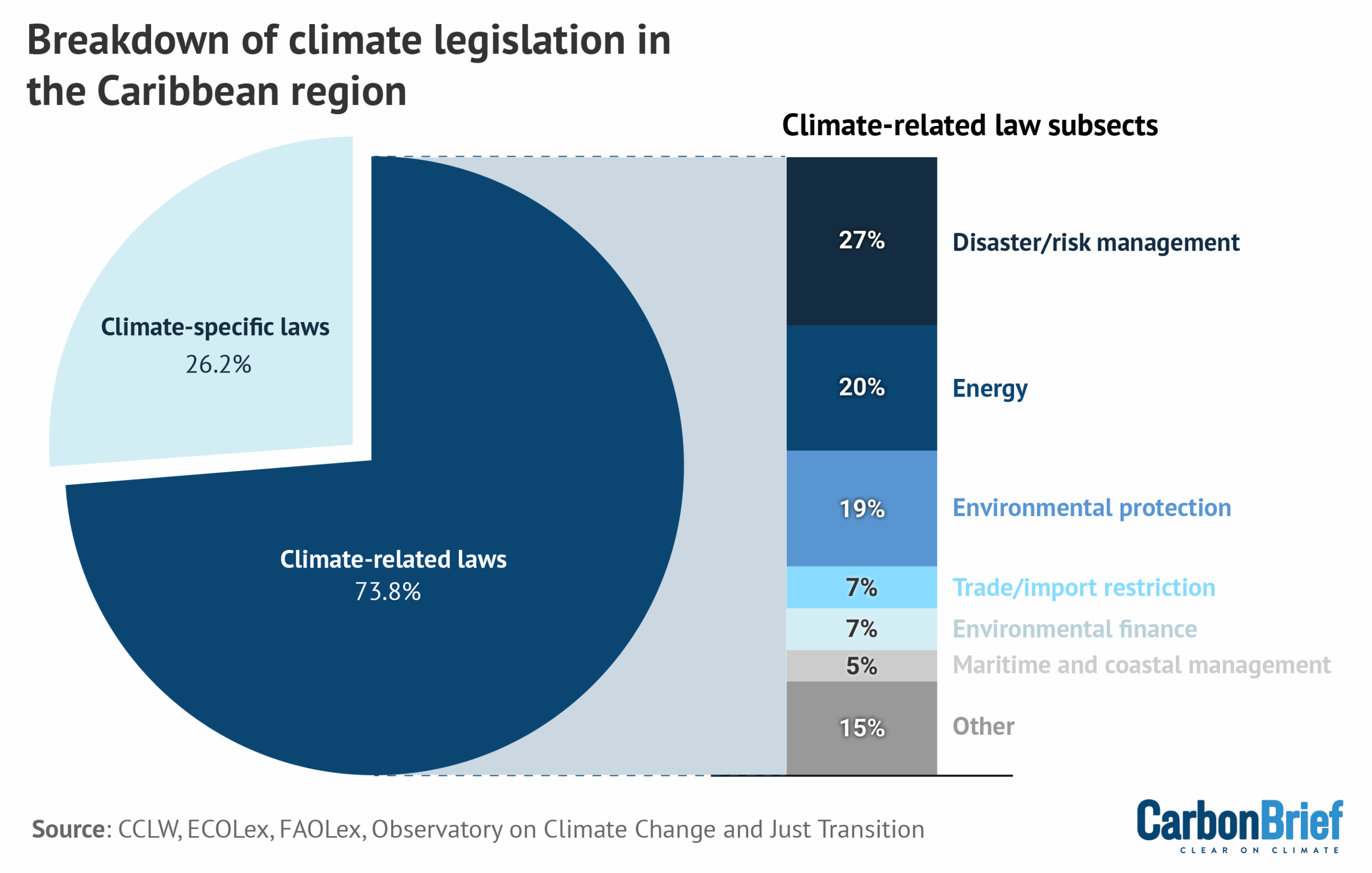
Caribbean nations are also advancing legal reforms to structure and institutionalise climate finance and market mechanisms directly into domestic law, aligned with Article 6.2 of the Paris Agreement.
For example, the Bahamas has introduced provisions for carbon credit trading, while Antigua and Barbuda, Barbados and Grenada have established national climate financing mechanisms to support mitigation and adaptation efforts.
Some states, including Belize and Saint Kitts and Nevis, have incorporated regional bodies such as the Caribbean Community Climate Change Centre – the climate arm of the intergovernmental Caribbean community organisation CARICOM – into national frameworks. This indicates an increasing alignment between regional cooperation and domestic law.
In addition to the influx of regulations specifically addressing climate change, Caribbean nations are also legislating broader environmental issues, which, in turn, could provide increased resilience from climate impacts and risks, as shown in the graph above.
Key trends in these types of climate-related laws include the expansion of disaster risk management governance, which addresses national preparedness for climate-induced weather events or related catastrophes. Likewise, energy law is an increasingly prominent focus, with countries including Antigua and Barbuda and Saint Vincent and the Grenadines integrating renewable energy and energy efficiency goals into national climate governance.
More broadly, many Caribbean nations have adopted wide-ranging and comprehensive environmental laws, many of which were developed in alignment with existing climate commitments. In combination, these legal developments reflect a dynamic and evolving climate governance landscape across the region.
Proactive vs reactive approaches
Despite general alignment with these broader regional trends, our research reveals distinct developmental pathways shaping domestic climate regulation.
In the eastern Caribbean, for example, we saw both proactive, long-term planning strategies and reactive, post-disaster reforms.
Saint Lucia’s multifaceted approach to climate resilience evolved steadily over the course of more than a decade. During this time, the country developed numerous adaptation plans, strengthened cross-sectoral coordination and engaged in institutional climate reforms in areas such as energy, tourism, finance and development.
More recently, the passage of Saint Lucia’s Climate Change Act in 2024 marked a milestone in climate governance, by giving legal force to the country’s obligations under the UNFCCC, the Kyoto Protocol and the Paris Agreement – making Saint Lucia one of the few small island states to incorporate global climate commitments into domestic law.
Our research indicates that this strategy has not only positioned the country as a more climate-resilient nation, but also solidified its access to international climate financing.
In contrast, Dominica’s efforts evolved more rapidly in the aftermath of Hurricane Maria in 2017, which destroyed over 200% of the country’s GDP. The storm’s impacts were felt across the country and hit particularly hard for the Kalinago people – the Caribbean’s last Indigenous community – highlighting the role of socioeconomic disparities in shaping climate vulnerability and resilience.
In response, the government passed the Climate Resilience Act, creating the temporary Climate Resilience Execution Agency for Dominica (CREAD).
Beyond establishing an exclusively climate-focused institution, the act aimed to embed resilience into governance by mandating the participation of vulnerable communities – including Indigenous peoples, women, older people and people with disabilities – in shaping and monitoring climate resilience projects.

As noted in a recent statement by the UN special rapporteur on Climate Change, Dr Elisa Morgera, these frameworks underscore the government’s ambition to become the world’s first “climate-resilient nation.”
Although challenges persist, Dominica’s efforts demonstrate how post-disaster urgency can drive institutional change, including the integration of rights and resilience into climate governance.
Uneven progress and structural gaps
Despite significant progress, our research shows that several key opportunities for climate governance across the Caribbean continue to exist, which could enable improvements in both resilience and long-term ambition.
The region’s legal landscape remains somewhat heterogeneous. While Saint Lucia has enacted a comprehensive climate framework law, the rest of the region lacks similar blanket legislation. This includes some states that entirely lack climate-specific laws, instead relying on related laws and frameworks to regulate and respond to climate-related risks.
Other nations have yet to adopt explicit disaster-risk management frameworks, leaving Caribbean populations vulnerable before, during and after climate emergencies. Most have yet to enshrine the right to a healthy environment at the national level.
Our research suggests that outdated legal frameworks are further limiting progress in addressing current climate risks. Because many of the longer-standing environmental laws in the region were adopted well before climate policy became a mainstream concern, some fail to address the nature, frequency and intensity of modern climate challenges, such as sea-level rise, tropical storms, wildfires, floods, droughts and other impacts.
More broadly, many Caribbean climate laws include limited integration of gender equity, Indigenous rights and social justice. As Caribbean nations such as Grenada and the Dominican Republic begin to link climate resilience with these issues, the region has an opportunity to lead by example.
Ultimately, capacity and resource constraints persist as significant barriers to implementation and adaptation.
The Caribbean region faces debt that exacerbates ongoing development challenges, a burden made heavier by the repeated economic shocks of climate-related disasters. Along with regional debt-for-resilience schemes, increased funding from high-emitting countries to support adaptation measures in climate-vulnerable nations – as endorsed under the Paris Agreement – is likely to be critical to ensuring the region’s climate laws can be executed effectively.
Global implications of Caribbean climate law
Our research suggests that Caribbean countries are outpacing other regions in terms of the scope and ambition of their climate laws. This legislation has the potential to serve as a model for climate-vulnerable nations worldwide.
Continuing efforts in the region show that legal frameworks in the field can not only drive resilience, embed rights and strengthen claims to international finance, but also highlight how regional cooperation and diplomacy can enhance global influence.
These findings demonstrate that innovation in climate law need not wait for action from major emitters, but can instead be led by those on the front lines of climate change.
The post Guest post: How Caribbean states are shifting climate legislation appeared first on Carbon Brief.
Guest post: How Caribbean states are shifting climate legislation
Greenhouse Gases
IEA: Renewables have cut fossil-fuel imports for more than 100 countries
More than 100 countries have cut their dependence on fossil-fuel imports and saved hundreds of billions of dollars by continuing to invest in renewables, according to the International Energy Agency (IEA).
It says nations such as the UK, Germany and Chile have reduced their need for imported coal and gas by around a third since 2010, mainly by building wind and solar power.
Denmark has cut its reliance on fossil-fuel imports by nearly half over the same period.
Renewable expansion allowed these nations to collectively avoid importing 700m tonnes of coal and 400bn cubic metres of gas in 2023, equivalent to around 10% of global consumption.
In doing so, the fuel-importing countries saved more than $1.3tn between 2010 and 2023 that would otherwise have been spent on fossil fuels from overseas.
Reduced reliance
The IEA’s Renewables 2025 report quantifies the benefits of renewable-energy deployment for electricity systems in fossil fuel-importing nations.
It compares recent trends in renewable expansion to an alternative “low renewable-energy source” scenario, in which this growth did not take place.
In this counterfactual, fuel-importing countries stopped building wind, solar and other non-hydropower renewable-energy projects after 2010.
In reality, the world added around 2,500 gigawatts (GW) of such projects between 2010 and 2023, according to the IEA, more than the combined electricity generating capacity of the EU and US in 2023, from all sources. Roughly 80% of this new renewable capacity was built in nations that rely on coal and gas imports to generate electricity.
The chart below shows how 31 of these countries have substantially cut their dependence on imported fossil fuels over the 13-year period, as a result of expanding their wind, solar and other renewable energy supplies. All of these countries are net importers of coal and gas.

In total, the IEA identified 107 countries that had reduced their dependence on fossil fuel imports for electricity generation, to some extent due to the deployment of renewables other than hydropower.
Of these, 38 had cut their reliance on electricity from imported coal and gas by more than 10 percentage points and eight had seen that share drop by more than 30 percentage points.
Security and resilience
The IEA stresses that renewables “inherently strengthen energy supply security”, because they generate electricity domestically, while also “improving…economic resilience” in fossil-fuel importer countries.
This is particularly true for countries with low or dwindling domestic energy resources.
The agency cites the energy crisis exacerbated by Russia’s invasion of Ukraine, which exposed EU importers to spiralling fossil-fuel prices.
Bulgaria, Romania and Finland – which have historically depended on Russian gas for electricity generation – have all brought their import reliance close to zero in recent years by building renewables.
In the UK, where there has been mounting opposition to renewables from right-wing political parties, the IEA says reliance on electricity generated with imported fossil fuels has dropped from 45% to under 25% in a decade, thanks primarily to the growth of wind and solar power.
Without these technologies, the UK would now be needing to import fossil fuels to supply nearly 60% of its electricity, the IEA says.
Other major economies, notably China and the EU, would also have had to rely on a growing share of coal and gas from overseas, if they had not expanded renewables.
As well as increasing the need for fossil-fuel imports from other countries, switching renewables for fossil fuels would require significantly higher energy usage “due to [fossil fuels’] lower conversion efficiencies”, the IEA notes. Each gigawatt-hour (GWh) of renewable power produced has avoided the need for 2-3GWh of fossil fuels, it explains.
Finally, the IEA points out that spending on renewables rather than imported fossil fuels keeps more investment in domestic economies and supports local jobs.
The post IEA: Renewables have cut fossil-fuel imports for more than 100 countries appeared first on Carbon Brief.
IEA: Renewables have cut fossil-fuel imports for more than 100 countries
-
Climate Change2 years ago
Spanish-language misinformation on renewable energy spreads online, report shows
-
Climate Change2 months ago
Guest post: Why China is still building new coal – and when it might stop
-
Climate Change Videos2 years ago
The toxic gas flares fuelling Nigeria’s climate change – BBC News
-

 Greenhouse Gases1 year ago
Greenhouse Gases1 year ago嘉宾来稿:满足中国增长的用电需求 光伏加储能“比新建煤电更实惠”
-
Greenhouse Gases2 months ago
Guest post: Why China is still building new coal – and when it might stop
-

 Climate Change1 year ago
Climate Change1 year ago嘉宾来稿:满足中国增长的用电需求 光伏加储能“比新建煤电更实惠”
-

 Carbon Footprint2 years ago
Carbon Footprint2 years agoUS SEC’s Climate Disclosure Rules Spur Renewed Interest in Carbon Credits
-
Renewable Energy3 months ago
US Grid Strain, Possible Allete Sale







